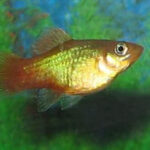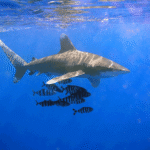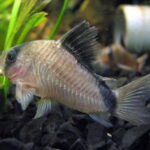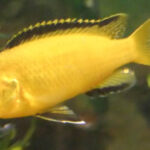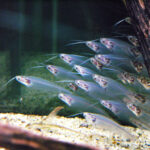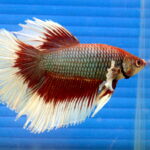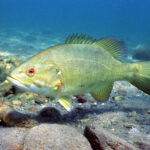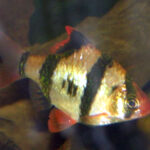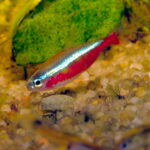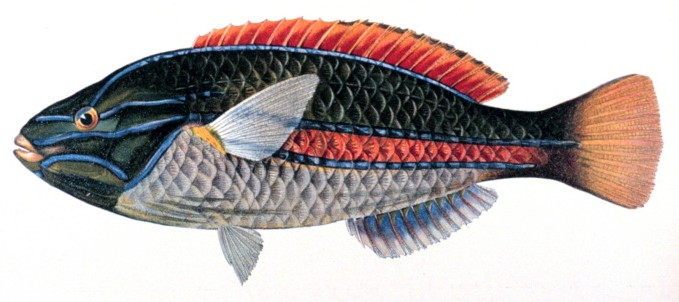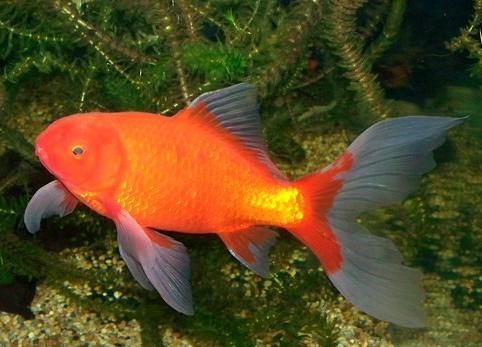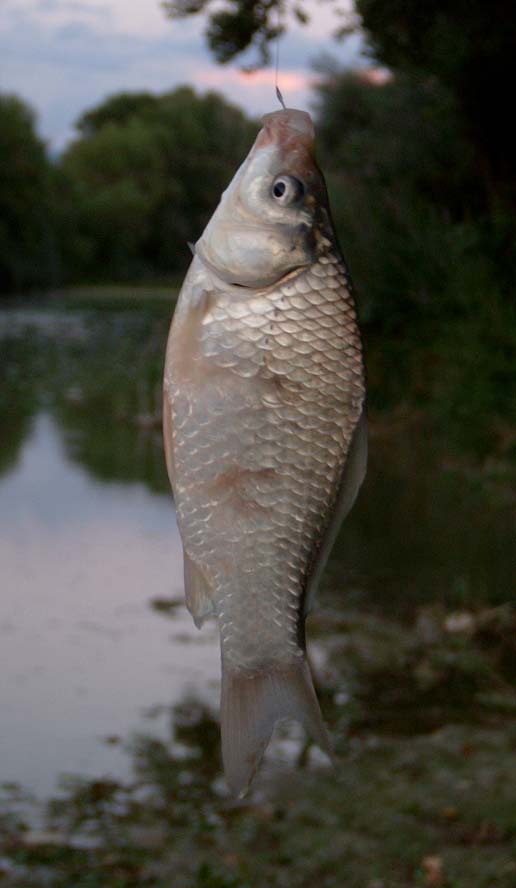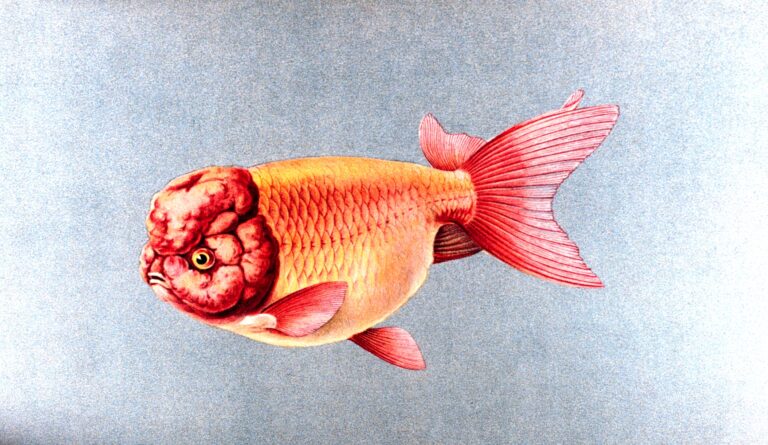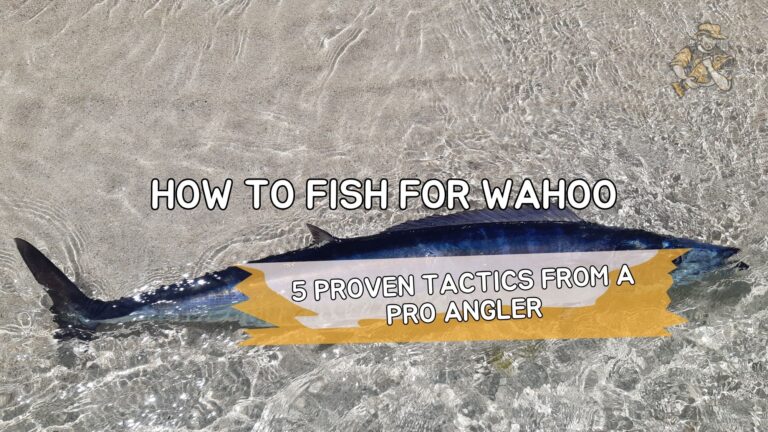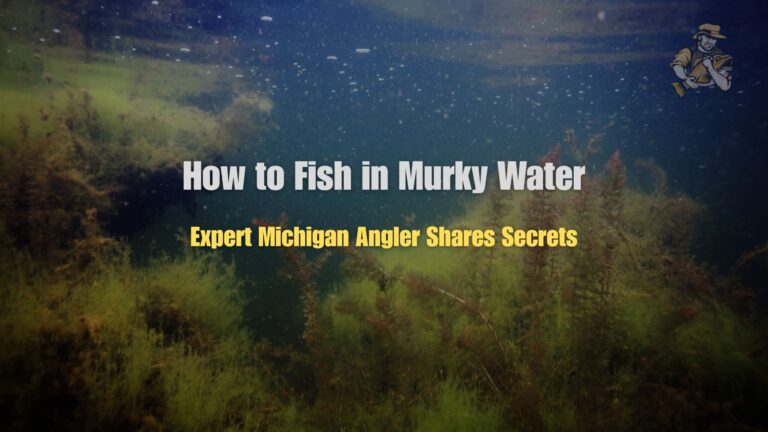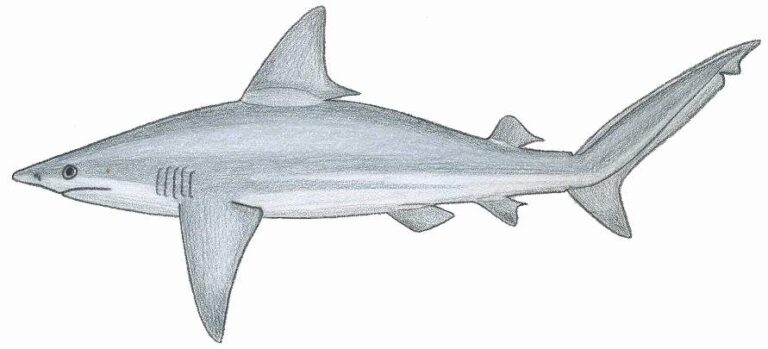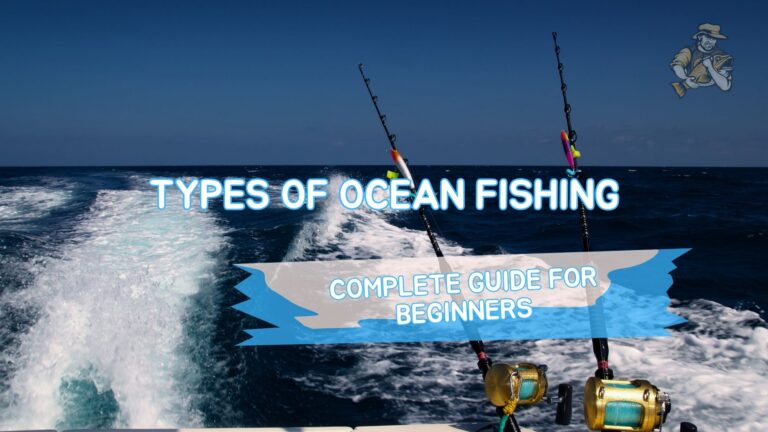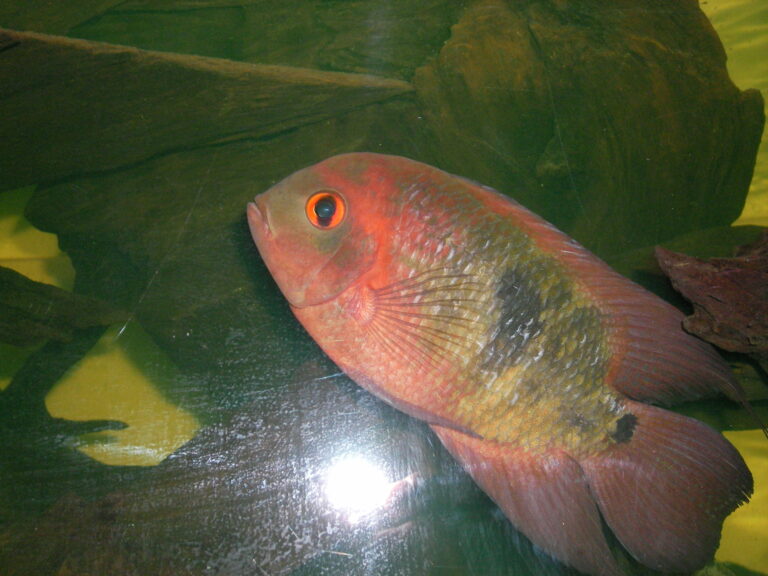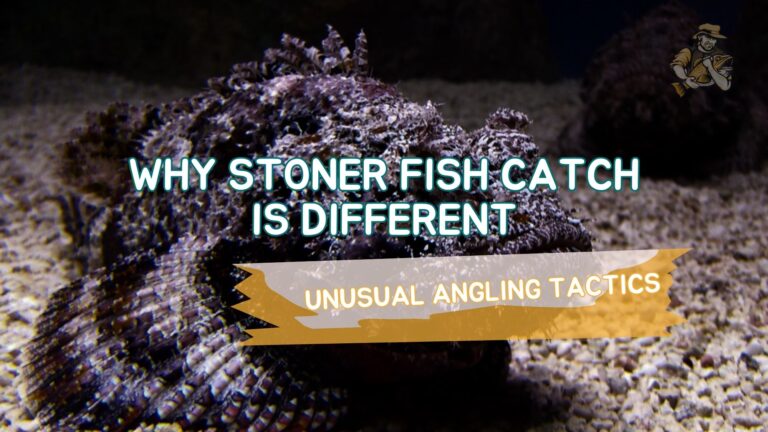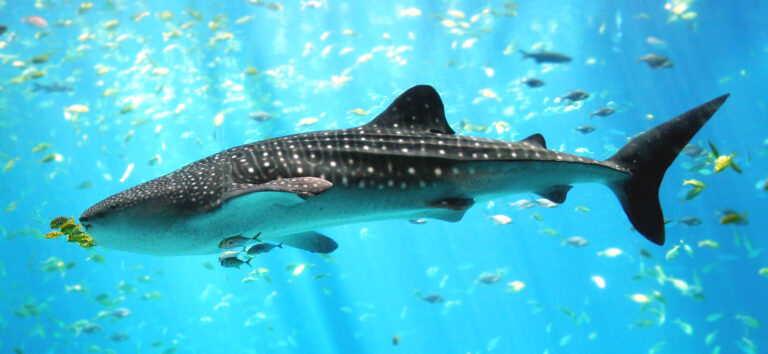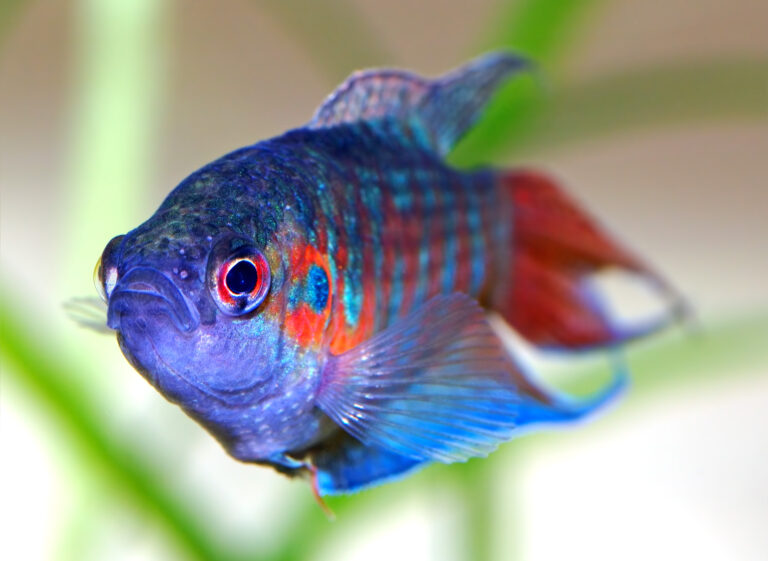Mosquito Fish
By Ryan Maron | Last Modified: June 11, 2025
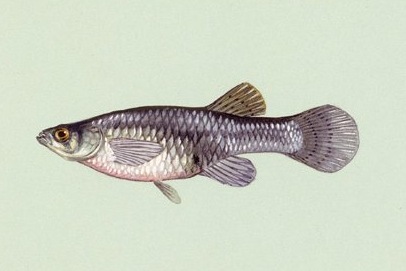
The Mosquito Fish (Gambusia affinis) stands as one of North America’s most ecologically significant freshwater species, despite its diminutive size. This small, hardy fish has earned its common name through its voracious appetite for mosquito larvae, consuming hundreds of these disease-carrying insects daily. Native to the southeastern United States, the Mosquito Fish has become a cornerstone species in biological pest control programs worldwide, introducing natural mosquito management to countless aquatic ecosystems.
From an ecological perspective, Gambusia affinis serves as both predator and prey within freshwater food webs. Its remarkable adaptability allows it to thrive in diverse aquatic environments, from stagnant ponds to flowing streams, making it invaluable for controlling mosquito populations in areas where chemical pesticides prove ineffective or environmentally harmful. The species’ prolific breeding capabilities and tolerance for varying water conditions have established it as a biological control agent in over 60 countries, though this widespread introduction has also raised important conservation concerns regarding native fish populations.
| Feature | Details |
|---|---|
| Common Name | Mosquito Fish |
| Scientific Name | Gambusia affinis |
| Family | Poeciliidae |
| Typical Size | 2.5-6 cm (1-2.4 inches), 0.1-0.3 grams |
| Habitat | Shallow freshwater environments |
| Diet | Insectivorous, primarily mosquito larvae |
| Distribution | Southeastern United States, introduced globally |
| Conservation Status | Least Concern |
Taxonomy & Classification
The Mosquito Fish belongs to the family Poeciliidae, a diverse group of freshwater fish commonly known as livebearers. Within this family, Gambusia affinis represents one of approximately 45 species in the Gambusia genus, sharing evolutionary lineage with other small, surface-dwelling fish adapted for consuming aquatic insects. The species was first scientifically described by Baird and Girard in 1853, with specimens collected from tributaries of the Rio Grande in Texas.
Taxonomically, the Mosquito Fish occupies the following classification hierarchy: Kingdom Animalia, Phylum Chordata, Class Actinopterygii, Order Cyprinodontiformes, Family Poeciliidae, Genus Gambusia, and Species affinis. The genus name “Gambusia” derives from the Cuban term “gambusino,” meaning worthless, though this designation hardly reflects the species’ ecological importance. The specific epithet “affinis” indicates its close relationship to other Gambusia species, particularly Gambusia holbrooki, the Eastern Mosquito Fish, with which it was once considered conspecific.
Recent molecular studies have revealed significant genetic diversity within Gambusia affinis populations, suggesting possible subspecies differentiation across its native range. Researchers have identified distinct genetic lineages corresponding to major river systems, including the Mississippi River basin and Gulf Coast drainages. These genetic variations may influence the species’ adaptability to different environmental conditions and its effectiveness as a biological control agent in various global introductions.
Physical Description
Mosquito Fish exhibit pronounced sexual dimorphism, with females significantly larger than males and displaying distinct reproductive adaptations. Adult females typically reach 3.5 to 6 centimeters in total length, while males remain smaller at 2.5 to 4 centimeters. This size differential reflects the species’ reproductive strategy, where larger females can produce more offspring and provide greater protection during gestation.
Female Mosquito Fish possess a robust, elongated body profile with a slightly compressed laterally appearance. Their coloration ranges from olive-brown to grayish-silver on the dorsal surface, transitioning to pale yellow or white on the ventral region. Dark spotting or mottled patterns often appear along the flanks, providing camouflage against predators and enhancing hunting efficiency in dappled light conditions. The dorsal fin contains 6 to 8 rays, while the anal fin features 8 to 10 rays, with both fins displaying rounded profiles.
Males exhibit a more streamlined body shape optimized for rapid maneuvering during courtship displays and territorial disputes. Their most distinctive feature is the modified anal fin, called a gonopodium, which serves as an intromittent organ for internal fertilization. This structure, formed by the elongation and fusion of anal fin rays three through five, can extend and retract during reproductive activities. Male coloration often intensifies during breeding seasons, with enhanced contrast between dorsal and ventral pigmentation and more pronounced lateral markings.
Both sexes possess large, forward-positioned eyes adapted for surface feeding and predator detection. Their upturned mouths, positioned at the superior angle of the head, facilitate efficient capture of surface-dwelling insects and larvae. The caudal fin displays a truncate to slightly rounded shape, providing adequate propulsion for short bursts of speed while maintaining energy efficiency during prolonged foraging activities.
Habitat & Distribution
The native range of Gambusia affinis encompasses the southeastern United States, extending from southern Illinois and Indiana southward through the Mississippi River basin to the Gulf of Mexico. This distribution includes major river systems such as the Mississippi, Missouri, Arkansas, and Red Rivers, along with numerous smaller tributaries and associated wetland complexes. The species originally inhabited slow-moving streams, oxbow lakes, marshes, and temporary pools throughout this region.
Mosquito Fish demonstrate remarkable habitat flexibility, occupying diverse freshwater environments from pristine mountain streams to heavily polluted urban waterways. They thrive in shallow waters typically less than one meter deep, where temperatures range from 10 to 35 degrees Celsius. These fish show exceptional tolerance for low dissolved oxygen levels, often surviving in conditions that would stress or kill other species. Their ability to utilize atmospheric oxygen through surface respiration allows them to exploit oxygen-depleted habitats unavailable to many competitors.
Water chemistry tolerance spans an impressive range, with Mosquito Fish surviving in pH levels from 5.0 to 9.0 and salinity concentrations up to 15 parts per thousand. This adaptability has enabled successful establishment in brackish water environments, including estuarine zones and salt-affected agricultural areas. Temperature tolerance extends from near-freezing conditions to water temperatures exceeding 40 degrees Celsius, though optimal performance occurs between 20 and 30 degrees Celsius.
Human-mediated introductions have established Mosquito Fish populations across six continents, excluding only Antarctica. These introductions, primarily for mosquito control purposes, have created established populations in Europe, Asia, Africa, Australia, and South America. Notable introduction sites include Mediterranean countries, where the species has become naturalized in irrigation systems and agricultural ponds, and Australia, where it occupies diverse freshwater habitats from coastal wetlands to inland river systems.
The species’ habitat preferences center on areas with abundant vegetation, fallen logs, or other structural complexity that provides shelter from predators and ambush points for prey capture. They frequently occupy the upper water column, rarely venturing below two meters depth, and show strong affinity for areas with gentle or no current flow. USGS wetland research has documented their preference for emergent vegetation zones where mosquito larvae concentrate, making these areas particularly productive hunting grounds.
Diet & Feeding Behavior
Mosquito Fish earn their common name through their exceptional consumption of mosquito larvae, with individual fish capable of consuming 100 to 500 larvae daily under optimal conditions. Their feeding strategy combines opportunistic foraging with specialized predation techniques adapted for surface-dwelling prey. The upward-angled mouth configuration allows efficient capture of insects, larvae, and other organisms at the water surface, while their forward-positioned eyes provide excellent binocular vision for precise strike accuracy.
The species exhibits a diverse omnivorous diet extending beyond mosquito larvae to include various aquatic invertebrates, small crustaceans, algae, and organic detritus. Dipteran larvae constitute the primary protein source, encompassing not only mosquito species but also chironomid midges, blackfly larvae, and other fly species. Copepods, cladocerans, and other zooplankton form significant dietary components, particularly during winter months when insect larvae become scarce.
Feeding behavior varies significantly with environmental conditions and prey availability. During peak mosquito breeding seasons, typically spring and summer months, Mosquito Fish concentrate their foraging efforts on larval aggregations in shallow, vegetated areas. They employ both active hunting strategies, where individuals patrol potential feeding areas, and ambush tactics, remaining motionless near the surface until prey approaches within striking distance.
Foraging patterns demonstrate distinct diel rhythms, with peak feeding activity occurring during dawn and dusk periods when mosquito larvae are most active near the surface. Water temperature strongly influences feeding rates, with consumption increasing proportionally with temperature until reaching optimal ranges between 25 and 30 degrees Celsius. Beyond these temperatures, feeding activity declines due to metabolic stress and reduced prey availability.
The species shows remarkable adaptability in feeding strategies when introduced to novel environments. In urban settings, they readily consume bread crumbs, fish food, and other anthropogenic food sources, though such items provide limited nutritional value compared to natural prey. Their ability to switch feeding strategies based on resource availability contributes significantly to their success as an introduced species across diverse global environments.
Juvenile Mosquito Fish initially feed on smaller prey items including rotifers, small copepods, and newly hatched insect larvae. As they grow, their diet expands to include larger prey items, with adult fish occasionally consuming small fish fry and tadpoles when available. This dietary flexibility enhances their survival in resource-limited environments and contributes to their effectiveness as biological control agents.
Behavior & Adaptations
Mosquito Fish display complex behavioral patterns that reflect their adaptation to variable freshwater environments and their role as both predator and prey species. Their social structure centers on loose aggregations rather than tight schooling behavior, with individuals maintaining territories during breeding seasons while forming feeding groups when prey concentrations warrant collective foraging efforts.
Territorial behavior intensifies during reproductive periods, with males establishing and defending small areas typically 0.5 to 2 square meters in size. These territories usually encompass optimal breeding sites near vegetation or structural cover, where males display to attract females and attempt to exclude competing males. Territorial disputes involve aggressive displays including fin spreading, lateral presentations, and direct physical confrontations that rarely result in serious injury.
The species demonstrates remarkable stress tolerance and behavioral flexibility when facing environmental challenges. During periods of low dissolved oxygen, Mosquito Fish exhibit aquatic surface respiration, positioning themselves at the water surface to access atmospheric oxygen through specialized mouth structures. This adaptation allows survival in severely degraded aquatic habitats where other fish species cannot persist.
Predator avoidance strategies include both behavioral and physiological responses to threat detection. When predators approach, Mosquito Fish employ rapid escape movements, diving behaviors, and seeking refuge within vegetation or structural cover. Their cryptic coloration provides additional protection through background matching, particularly effective in shallow, vegetated environments where dappled light creates natural camouflage patterns.
Temperature regulation behaviors become crucial during extreme weather conditions. In cold climates, Mosquito Fish seek deeper water areas or bury themselves in sediment during winter months, entering a state of reduced metabolic activity similar to hibernation. Conversely, during hot weather, they move to shaded areas or deeper water to avoid thermal stress while maintaining access to surface prey.
The species exhibits learning capabilities and memory retention, particularly regarding predator recognition and feeding site locations. Research has demonstrated that individual fish can learn to associate environmental cues with feeding opportunities and modify their behavior accordingly. This cognitive flexibility contributes to their success in novel environments and enhances their effectiveness as biological control agents.
Group dynamics shift seasonally, with larger aggregations forming during winter months when individuals seek thermal refugia in deeper areas. Spring warming triggers dispersal as fish move to shallow breeding areas and establish territories. These seasonal movement patterns can span several kilometers in connected waterway systems, though most individuals remain within relatively small home ranges throughout their lives.
Reproduction & Life Cycle
Gambusia affinis employs a livebearing reproductive strategy that provides significant advantages in unpredictable aquatic environments. Unlike egg-laying species vulnerable to environmental fluctuations during development, Mosquito Fish carry developing embryos internally, protecting them from predation, temperature extremes, and water quality variations until they reach sufficient size for independent survival.
The reproductive cycle begins with courtship behaviors initiated by males during optimal breeding conditions, typically when water temperatures exceed 20 degrees Celsius and daylight hours increase. Males establish territories in shallow, vegetated areas and engage in elaborate courtship displays involving rapid swimming patterns, fin displays, and approach behaviors toward receptive females. Successful mating involves the male using his modified anal fin, the gonopodium, to transfer sperm packets directly into the female’s reproductive tract.
Female Mosquito Fish store sperm in specialized structures called spermatheca, allowing multiple fertilizations from a single mating event over several months. This reproductive adaptation enables continued reproduction even when male density is low or environmental conditions limit mating opportunities. Gestation periods range from 21 to 28 days, depending on water temperature, with warmer conditions accelerating embryonic development.
Brood sizes vary considerably based on female size, age, and environmental conditions, ranging from 10 to 80 offspring per reproductive event. Larger, older females typically produce larger broods with higher survival rates. Newly born fry measure approximately 6 to 8 millimeters in total length and possess fully developed fins and functional digestive systems, enabling immediate independent feeding and predator avoidance.
The reproductive frequency of Mosquito Fish represents one of their most remarkable adaptations, with females capable of producing multiple broods throughout the breeding season. In optimal conditions, females may produce offspring every 4 to 6 weeks from spring through fall, resulting in 3 to 5 broods annually. This high reproductive output contributes significantly to population growth rates and colonization success in new environments.
Sexual maturity occurs rapidly, with individuals reaching reproductive capability at 2 to 3 months of age under favorable conditions. Males typically mature earlier than females, reflecting the energetic demands of gestation and larger body size requirements in females. Maximum lifespan in natural conditions ranges from 1 to 2 years, though laboratory studies have documented individuals surviving up to 3 years under optimal conditions.
Environmental factors strongly influence reproductive success and timing. Water temperature serves as the primary cue for reproductive activity, with breeding ceasing when temperatures drop below 15 degrees Celsius. Photoperiod changes also affect reproductive cycles, with increasing daylight hours triggering hormonal changes that initiate breeding behaviors. Nutritional status significantly impacts reproductive output, with well-fed females producing larger, more frequent broods than those in resource-limited environments.
The species exhibits density-dependent reproductive responses, with overcrowded populations showing reduced individual reproductive success but maintained population-level output. This mechanism helps prevent population crashes while ensuring continued recruitment under varying environmental conditions.
Predators & Threats
Mosquito Fish face predation pressure from numerous aquatic and terrestrial species throughout their range, influencing their behavior, distribution patterns, and evolutionary adaptations. Aquatic predators include larger fish species such as largemouth bass, sunfish, catfish, and gar, which readily consume both juvenile and adult Mosquito Fish. Wading birds including herons, egrets, and ibises represent significant avian predators, particularly in shallow water habitats where Mosquito Fish concentrate.
Predation intensity varies seasonally and by habitat type, with highest mortality occurring during spring and summer months when predator activity peaks and Mosquito Fish occupy shallow, exposed areas for breeding. Juvenile mortality rates can exceed 90 percent in environments with high predator density, though rapid reproductive rates compensate for these losses at the population level.
Introduced predator species pose increasing threats in many parts of the Mosquito Fish’s range. Non-native fish such as various bass species, northern pike, and introduced cichlids have altered predator-prey dynamics in numerous water bodies. These changes can significantly impact local Mosquito Fish populations, particularly in isolated habitats where escape opportunities are limited.
Habitat modification represents a growing threat category, with urban development, agricultural expansion, and water management practices altering natural aquatic environments. Channelization of streams eliminates the shallow, vegetated areas preferred by Mosquito Fish, while dam construction fragments populations and alters flow regimes essential for reproductive success. Agricultural runoff introduces pesticides and fertilizers that can directly harm Mosquito Fish or eliminate their prey base.
Water quality degradation affects Mosquito Fish populations through multiple pathways. While these fish demonstrate remarkable tolerance for pollution, extreme contamination levels can exceed their physiological limits. Heavy metals, industrial chemicals, and excessive nutrients can cause direct mortality or sublethal effects that reduce reproductive success and increase vulnerability to predation and disease.
Climate change presents emerging challenges through altered precipitation patterns, increased frequency of extreme weather events, and shifting temperature regimes. Prolonged droughts can eliminate temporary water bodies essential for population dispersal and genetic exchange, while intense rainfall events can flush populations from established habitats or introduce harmful contaminants.
Competition with native species creates additional pressure in some environments, particularly where Mosquito Fish have been introduced outside their native range. Their aggressive feeding behavior and high reproductive rates can negatively impact native fish communities, leading to management conflicts and potential population control efforts.
Disease and parasites affect Mosquito Fish populations, though they generally show good resistance to common fish pathogens. Viral and bacterial infections can cause localized population declines, particularly in overcrowded or stressed populations. Parasitic infections, including various protozoans and helminths, can reduce individual fitness and reproductive success while rarely causing widespread mortality.
Human collection for bait use, aquarium trade, and biological control programs can impact local populations, though sustainable harvest practices minimize these effects. Illegal or unregulated collection can significantly reduce population density in accessible areas, particularly where Mosquito Fish serve as important biological control agents.
Conservation Status
The International Union for Conservation of Nature (IUCN) classifies Gambusia affinis as a species of Least Concern, reflecting its widespread distribution, stable populations, and successful establishment in numerous introduced ranges. Within its native southeastern United States range, Mosquito Fish populations remain generally stable, though localized declines have occurred in some areas due to habitat modification and water quality degradation.
Population monitoring throughout the native range indicates that Mosquito Fish maintain healthy numbers in most major river systems and associated wetland complexes. Their adaptability to human-modified environments has actually benefited some populations, with irrigation systems, constructed wetlands, and urban storm water management facilities providing additional habitat opportunities. However, this adaptability masks concerning trends in native aquatic ecosystem health and biodiversity.
Conservation challenges arise primarily from the species’ role as an introduced organism rather than threats to native populations. While Mosquito Fish themselves face no immediate extinction risk, their widespread introduction for biological control purposes has created complex conservation dilemmas. In many regions, introduced Mosquito Fish populations have negatively impacted native fish communities through competition, predation, and habitat modification.
Several countries have implemented management programs to control introduced Mosquito Fish populations where they threaten endemic species. Australia has developed comprehensive strategies for managing Mosquito Fish impacts on native fish communities, including habitat restoration, selective removal programs, and research into biological control methods. Similar efforts in European countries focus on preventing further spread while protecting vulnerable native species in critical habitats.
The dual nature of Mosquito Fish conservation status creates unique management challenges. While protecting the species within its native range remains important for maintaining ecosystem integrity, controlling their impacts in introduced ranges has become a conservation priority. This situation highlights the complex relationships between species conservation and invasive species management in global conservation efforts.
Research priorities include developing better understanding of genetic diversity within native populations, identifying critical habitats requiring protection, and assessing long-term population trends in response to climate change and habitat modification. Studies of introduced populations focus on impact assessment, control methods, and prevention of further spread to sensitive environments.
Climate change adaptation strategies for native Mosquito Fish populations include protecting habitat connectivity, maintaining water quality standards, and preserving refugia areas during extreme weather events. These efforts require coordination between federal, state, and local agencies along with private landowners and conservation organizations.
The species’ conservation status reflects broader challenges in balancing human needs for biological pest control with ecosystem preservation goals. Continued monitoring and adaptive management approaches will be essential for maintaining healthy native populations while addressing conservation concerns in introduced ranges.
Human Interaction
The relationship between humans and Mosquito Fish represents one of the most extensive examples of biological control in aquatic ecosystems, spanning over a century of intentional introductions for public health purposes. Beginning in the early 1900s, public health agencies recognized the potential of these small fish to control disease-carrying mosquito populations, leading to systematic introduction programs across the globe.
Mosquito Fish have been introduced to over 60 countries as part of malaria and other mosquito-borne disease control programs. The World Health Organization has historically supported these introductions in regions where chemical pesticides proved ineffective or environmentally harmful. Successful programs have been documented in Mediterranean countries, parts of Asia, and various tropical regions where mosquito-borne diseases pose significant public health risks.
The aquarium trade represents another significant avenue of human interaction with Mosquito Fish. Their hardiness, ease of breeding, and interesting behaviors make them popular among aquarists, particularly those maintaining outdoor pond systems. However, their prolific reproduction and potential for escape into natural water bodies have raised concerns about unintentional introductions through aquarium release.
Educational programs utilize Mosquito Fish as demonstration species for teaching concepts of biological control, predator-prey relationships, and aquatic ecology. Their accessibility and observable behaviors make them valuable tools for environmental education, though educators must emphasize responsible handling and disposal to prevent unwanted introductions.
Basic fishing techniques occasionally target Mosquito Fish as bait species, though their small size limits their utility compared to larger baitfish. Some anglers collect them from established populations for use in targeting larger predatory fish, particularly in areas where commercial bait is unavailable or expensive.
Research applications employ Mosquito Fish extensively in toxicology studies, behavioral research, and ecological investigations. Their standardized laboratory culture makes them valuable model organisms for studying environmental contamination effects, genetic diversity patterns, and population dynamics under controlled conditions. Standardized testing protocols using Mosquito Fish help assess water quality and chemical toxicity in environmental monitoring programs.
Agricultural applications include their use in controlling mosquito populations in irrigation systems, livestock watering facilities, and constructed wetlands used for wastewater treatment. Farmers and ranchers often introduce Mosquito Fish to reduce insect pest populations that affect livestock health and agricultural productivity.
Water management agencies incorporate Mosquito Fish into integrated pest management strategies for constructed wetlands, storm water retention ponds, and other engineered aquatic systems. Their effectiveness in controlling mosquito breeding while tolerating variable water quality conditions makes them valuable components of urban water management infrastructure.
The growing awareness of invasive species impacts has led to increased regulation of Mosquito Fish introductions and transport. Many jurisdictions now require permits for intentional releases and prohibit transportation of live specimens to prevent unauthorized introductions. Public education campaigns emphasize the importance of obtaining proper authorization before introducing any fish species to natural waters.
Citizen science programs engage volunteers in monitoring Mosquito Fish populations, documenting their distribution, and assessing their ecological impacts. These programs provide valuable data for researchers while educating participants about aquatic ecosystem dynamics and conservation challenges. Fishing tips for beginners often include information about identifying and responsibly handling small fish species like Mosquito Fish during recreational activities.
Interesting Facts
Mosquito Fish possess the remarkable ability to survive in water with oxygen levels as low as 0.5 parts per million, a concentration that would be lethal to most other fish species. This extraordinary adaptation allows them to exploit habitats unavailable to competitors and explains their success in polluted urban waterways and stagnant pools where other fish cannot survive.
The species exhibits fascinating temperature adaptation mechanisms, including the ability to adjust their metabolic rates seasonally. During winter months, Mosquito Fish can reduce their metabolic activity by up to 80 percent, effectively entering a state similar to mammalian hibernation while remaining active enough to respond to feeding opportunities and predator threats.
Female Mosquito Fish demonstrate a unique reproductive strategy called superfetation, where they can carry multiple broods at different developmental stages simultaneously. This adaptation allows continuous reproduction throughout the breeding season without the downtime typically associated with single-brood species, contributing significantly to their rapid population growth rates.
Research has revealed that Mosquito Fish can learn and remember feeding locations for up to several weeks, displaying cognitive abilities previously unrecognized in such small fish. They can associate environmental cues with food availability and modify their foraging behavior based on previous experiences, suggesting more complex neural processing than initially assumed.
The species exhibits remarkable salinity tolerance, surviving in water with salt concentrations up to 15 parts per thousand, approximately 40 percent of seawater salinity. This adaptation enables them to colonize brackish water environments and survive in agricultural areas affected by salt accumulation from irrigation practices.
Mosquito Fish populations can reach extraordinary densities under optimal conditions, with documented concentrations exceeding 1,000 individuals per square meter in small pools with abundant food resources. These high-density aggregations create intense competition but also demonstrate the species’ efficiency in exploiting concentrated food sources.
Individual Mosquito Fish have been documented consuming their own body weight in mosquito larvae daily during peak feeding periods. This consumption rate far exceeds that of most other insectivorous fish species and underlies their effectiveness as biological control agents in mosquito management programs.
The species possesses specialized cells called iridophores that can rapidly change their reflective properties, allowing quick color adjustments for camouflage purposes. This physiological adaptation enables them to match background colors within seconds, providing enhanced protection from visual predators.
Mosquito Fish demonstrate unusual parental behavior for livebearing species, with females occasionally providing protection to their offspring for several days after birth. While not true parental care, this behavior increases juvenile survival rates and represents an evolutionary step toward more advanced parental investment strategies.
The species’ introduction history includes some of the earliest documented biological control programs, with the first intentional releases occurring in Hawaii in 1905 for malaria control. These early programs established protocols and evaluation methods still used in biological control introductions today.
Research has identified distinct genetic lineages within Mosquito Fish populations that show different levels of effectiveness against various mosquito species. Some populations demonstrate specialized adaptations for consuming specific types of larvae, suggesting potential for targeted biological control applications based on genetic selection.
Guppy populations share similar reproductive strategies and habitat preferences with Mosquito Fish, leading to interesting comparative studies of livebearing fish adaptations. The species can hybridize with closely related Gambusia species, though hybrid offspring typically show reduced fitness compared to pure species individuals.
Frequently Asked Questions
Are Mosquito Fish effective for controlling mosquito populations in backyard ponds?
Mosquito Fish can be highly effective for controlling mosquito larvae in backyard ponds and water features, consuming hundreds of larvae daily per individual. However, their effectiveness depends on proper pond management, including maintaining adequate fish populations, providing appropriate habitat structure, and ensuring water quality remains within acceptable ranges. Property owners should check local regulations before introducing Mosquito Fish, as permits may be required in some jurisdictions.
Can Mosquito Fish survive winter conditions in temperate climates?
Mosquito Fish show limited cold tolerance and typically cannot survive prolonged freezing conditions. In temperate regions, they require water depths sufficient to prevent complete freezing, usually at least 60 centimeters deep. Many introduced populations in northern climates depend on heated water sources or indoor overwintering to maintain viable populations. Their cold sensitivity limits natural range expansion into regions with harsh winters.
Do Mosquito Fish pose threats to native fish species?
Introduced Mosquito Fish populations can negatively impact native fish communities through competition for food resources, predation on eggs and larvae, and aggressive interactions. Their rapid reproduction and adaptability often allow them to outcompete native species in disturbed habitats. However, impacts vary significantly depending on local ecosystem conditions, native species present, and habitat quality. Proper impact assessment should precede any introduction program.
How can I distinguish Mosquito Fish from similar small fish species?
Mosquito Fish can be identified by their upturned mouths, compressed body shape, and distinctive sexual dimorphism. Females are noticeably larger than males, while males possess a modified anal fin called a gonopodium. Their coloration typically shows olive-brown backs with lighter sides, and they lack the bright colors often seen in related aquarium species. Molly fish species share similar body shapes but typically display different coloration patterns and size ranges.
Conclusion
The Mosquito Fish stands as a testament to the complex relationships between human intervention and ecological systems, serving simultaneously as a valuable biological control agent and a cautionary example of introduction consequences. While their effectiveness in controlling disease-carrying mosquito populations has provided significant public health benefits globally, their impacts on native aquatic communities highlight the importance of careful consideration in species management decisions. Continued research and monitoring will be essential for optimizing their beneficial uses while minimizing ecological disruption in sensitive environments.
Share The Article:
More Fish Species:
-
Rainbowfish
Rainbowfish represent one of the most visually striking and ecologically significant groups of freshwater fish found across Australia, New…
-
Comet Goldfish
The Comet Goldfish (Carassius auratus) stands as one of the most recognizable and widely distributed freshwater fish species in…
-
Goldfish
The goldfish (Carassius auratus) stands as one of the most culturally significant and scientifically fascinating species in freshwater aquaculture…
-
Pleco
The **Pleco**, scientifically known as *Pterygoplichthys multiradiatus* (common pleco), represents one of the most recognizable and ecologically significant groups…
-
Ranchu Goldfish
The Ranchu Goldfish represents one of the most distinctive and culturally significant ornamental fish varieties in the aquatic world….
-
Siamese Fighting Fish
The Siamese Fighting Fish, scientifically known as *Betta splendens*, stands as one of the most recognizable and culturally significant…
Discover
-
How to Fish for Wahoo: 5 Proven Tactics from a Pro Angler
If there’s one fish that’s made me question my sanity over the years, it’s the wahoo. These lightning-fast predators…
-
7 Best Places to Go Fishing in Florida (2025 Guide for All Anglers)
Florida’s known as the Fishing Capital of the World for good reason. With over 7,700 lakes, 10,550 miles of…
-
North Jersey Fishing Guide: Best Lakes, Rivers & Seasons
If you’ve never experienced the fishing in North Jersey, you’re missing out on some genuinely underrated angling opportunities. From…
-
How to Fish in Murky Water: Expert Michigan Angler Shares Secrets
Last Tuesday, I was standing knee-deep in chocolate-colored water where Kellogg Creek dumps into the Kalamazoo River. Water visibility:…
-
Sandbar Shark
The Sandbar Shark (Carcharhinus plumbeus) stands as one of the most recognizable and ecologically significant members of the requiem…
-
Types of Ocean Fishing: Complete Guide for Beginners
There’s something magical about standing at the edge of the vast ocean with a fishing rod in hand. I’ve…
Discover
-
Chocolate Cichlid
The Chocolate Cichlid stands as one of South America’s most distinctive freshwater species, captivating aquarists and researchers alike with…
-
Smallmouth Black Bass Fishing: Complete Guide for 2025
If you’ve ever felt that sudden, powerful tug on your line followed by an acrobatic jump that leaves your…
-
Why Stoner Fish Catch is Different: Unusual Angling Tactics
Let’s face it – some fish just act plain weird. Whether you’re an experienced angler or just starting out,…
-
How to Use a Spinnerbait: Complete Guide for Beginners
In my three decades of fishing experience, I’ve found few lures as versatile and effective as the humble spinnerbait….
-
Whale Shark
The whale shark (*Rhincodon typus*) stands as the ocean’s largest fish species, representing one of nature’s most remarkable gentle…
-
Paradise Fish
The Paradise Fish stands as one of the most remarkable representatives of the labyrinth fish family, captivating aquarists and…

